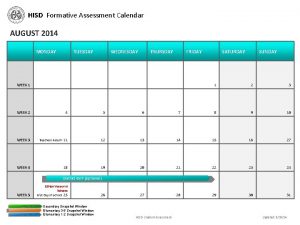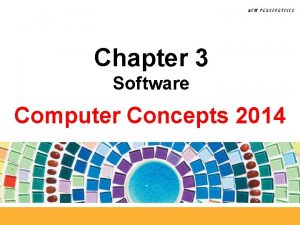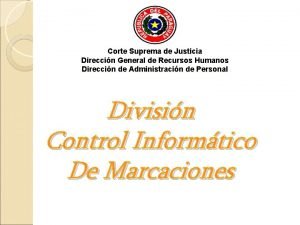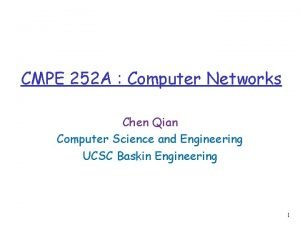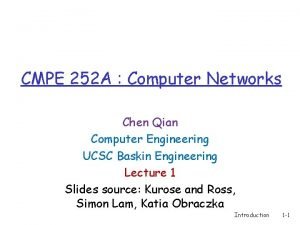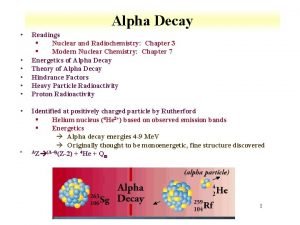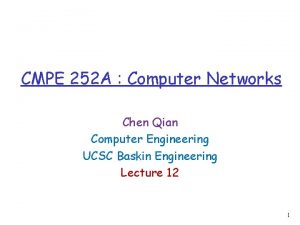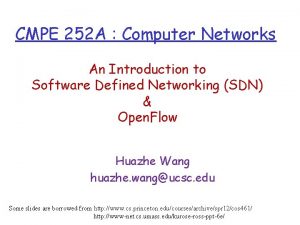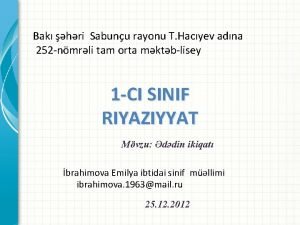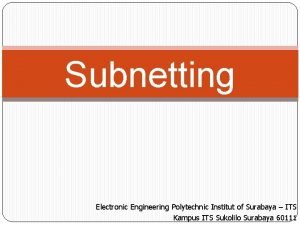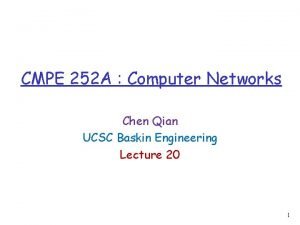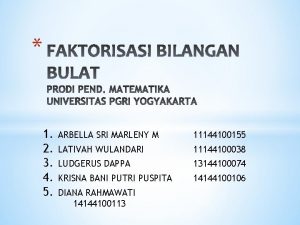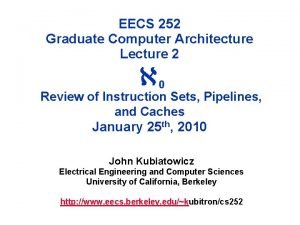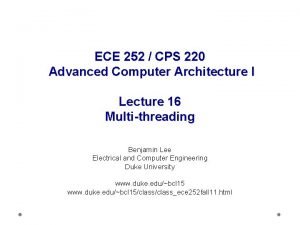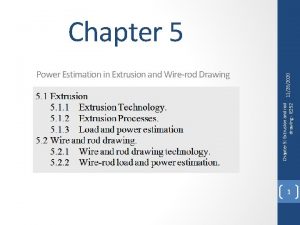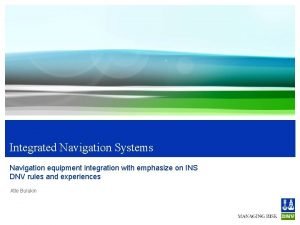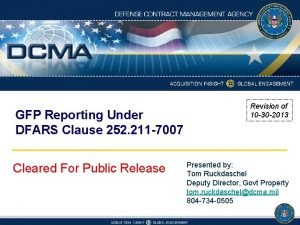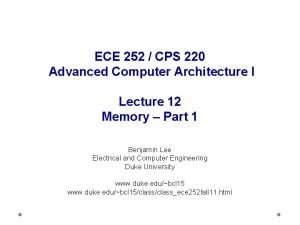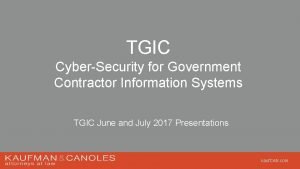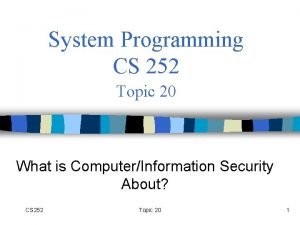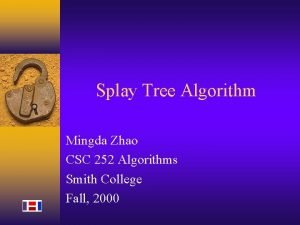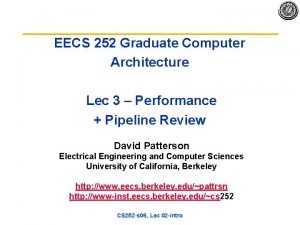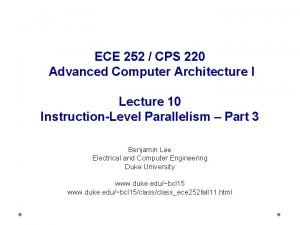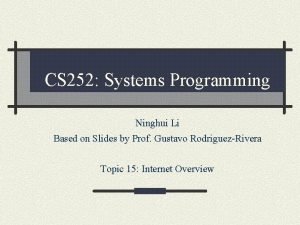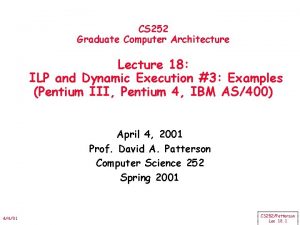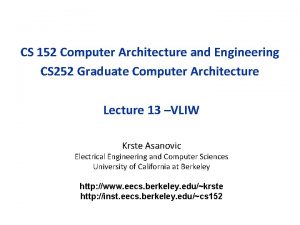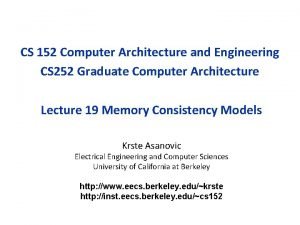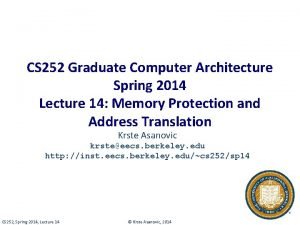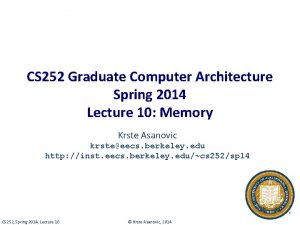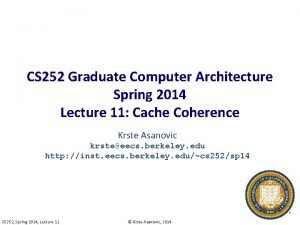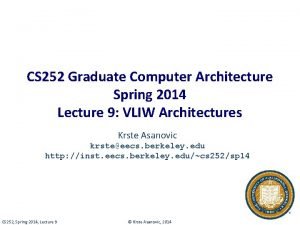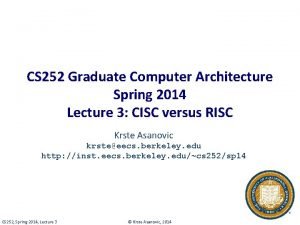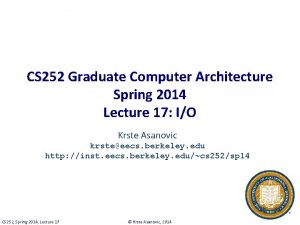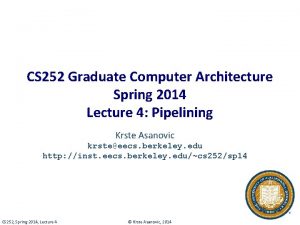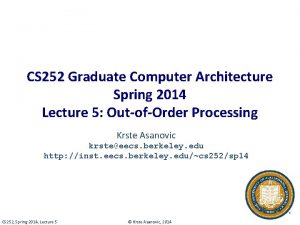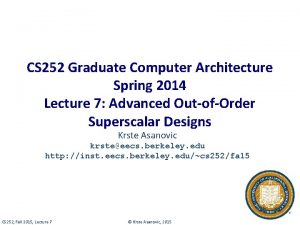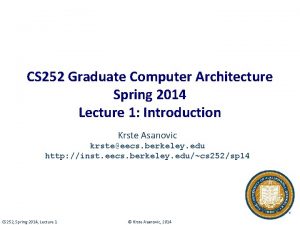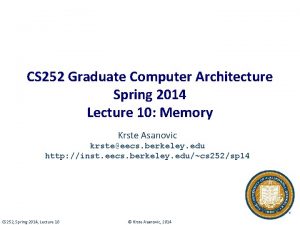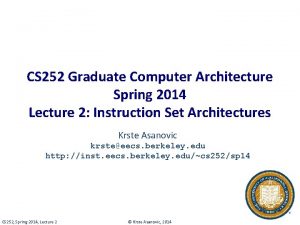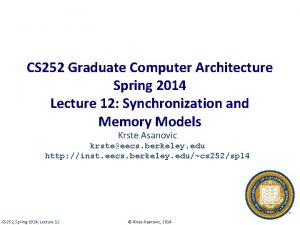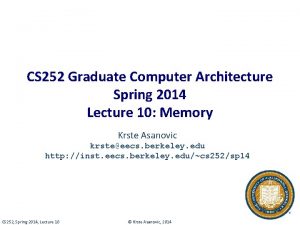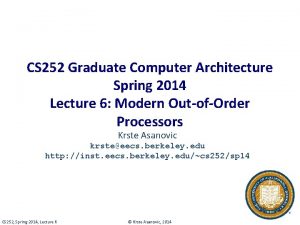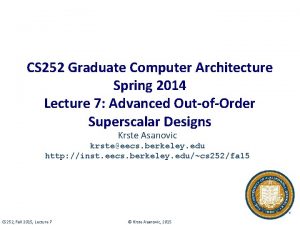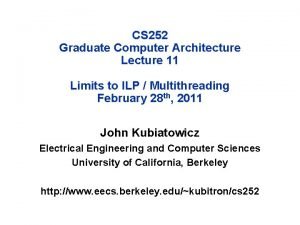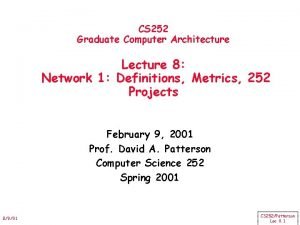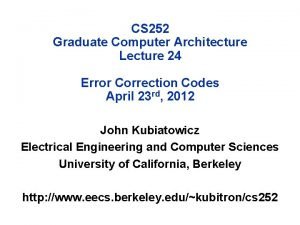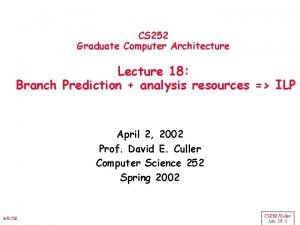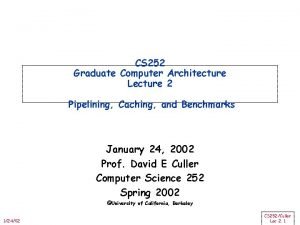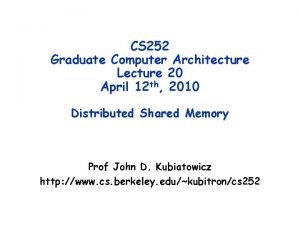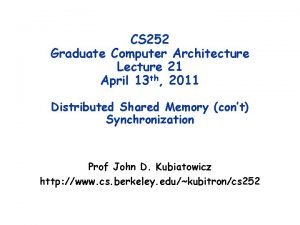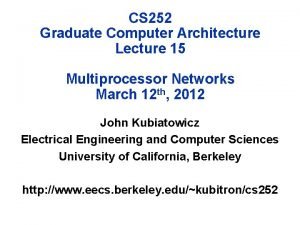CS 252 Graduate Computer Architecture Spring 2014 Lecture

















![Implementing Complex Instructions Memory-memory add: M[rd] = M[rs 1] + M[rs 2] µPC MMA Implementing Complex Instructions Memory-memory add: M[rd] = M[rs 1] + M[rs 2] µPC MMA](https://slidetodoc.com/presentation_image_h2/703b94c51133475943690bcbcae46b5f/image-18.jpg)














![[ Personal Computing Ad, 11/81] CS 252, Spring 2014, Lecture 3 © Krste Asanovic, [ Personal Computing Ad, 11/81] CS 252, Spring 2014, Lecture 3 © Krste Asanovic,](https://slidetodoc.com/presentation_image_h2/703b94c51133475943690bcbcae46b5f/image-33.jpg)









- Slides: 42

CS 252 Graduate Computer Architecture Spring 2014 Lecture 3: CISC versus RISC Krste Asanovic krste@eecs. berkeley. edu http: //inst. eecs. berkeley. edu/~cs 252/sp 14 CS 252, Spring 2014, Lecture 3 © Krste Asanovic, 2014

Last Time in Lecture 2 § First 130 years of Comp. Arch, from Babbage to IBM 360 - Move from calculators (no conditionals) to fully programmable machines - Rapid change started in WWII (mid-1940 s), move from electro-mechanical to pure electronic processors § Cost of software development becomes a large constraint on architecture (need compatibility) § IBM 360 introduces notion of “family of machines” running same ISA but very different implementations - Six different machines released on same day (April 7, 1964) - “Future-proofing” for subsequent generations of machine CS 252, Spring 2014, Lecture 3 © Krste Asanovic, 2014 2

Instruction Set Architecture (ISA) § The contract between software and hardware § Typically described by giving all the programmer-visible state (registers + memory) plus the semantics of the instructions that operate on that state § IBM 360 was first line of machines to separate ISA from implementation (aka. microarchitecture) § Many implementations possible for a given ISA - E. g. , the Soviets build code-compatible clones of the IBM 360, as did Amdahl after he left IBM. - E. g. 2. , today you can buy AMD or Intel processors that run the x 86 -64 ISA. - E. g. 3: many cellphones use the ARM ISA with implementations from many different companies including TI, Qualcomm, Samsung, Marvell, etc. § We use Berkeley RISC-V 2. 0 as standard ISA in class - www. riscv. org CS 252, Spring 2014, Lecture 3 © Krste Asanovic, 2014 3

Control versus Datapath § Processor designs can be split between datapath, where numbers are stored and arithmetic operations computed, and control, which sequences operations on datapath § Biggest challenge for early computer designers was getting control circuitry correct § Maurice Wilkes invented the Control Registers ALU Address Data Inst. Reg. PC Datapath Instruction Control Lines Condition? Busy? idea of microprogramming to design the control unit of a processor for EDSAC-II, 1958 - Foreshadowed by Babbage’s “Barrel” and mechanisms in earlier programmable calculators Main Memory CS 252, Spring 2014, Lecture 3 © Krste Asanovic, 2014 4

Technology Influence § When microcode appeared in 50 s, different technologies for: - Logic: Vacuum Tubes - Main Memory: Magnetic cores - Read-Only Memory: Diode matrix, punched metal cards, … § Logic very expensive compared to ROM or RAM § ROM cheaper than RAM § ROM much faster than RAM CS 252, Spring 2014, Lecture 3 © Krste Asanovic, 2014 5

Microcoded CPU Next State Condition Opcode Busy? µPC Microcode ROM (holds fixed µcode instructions) Decoder Control Lines Datapath Address Data Main Memory (holds user program written in macroinstructions, e. g. , x 86, RISC-V) CS 252, Spring 2014, Lecture 3 © Krste Asanovic, 2014 6

ALU ALUEn Mem. W MALd Mem. Address BLd ALUOp A ALd Reg. En B Reg. W Registers Imm. Sel Immediate Imm. En Address Data Out In Busy? Condition? Reg. Sel Register RAM PC Inst. Ld Instruction Reg. Opcode rs 1 rs 2 rd 32 (PC) Single Bus Datapath for Microcoded RISC-V Main Memory Mem. En Microinstructions written as register transfers: § MA: =PC means Reg. Sel=PC; Reg. W=0; Reg. En=1; MALd=1 § B: =Reg[rs 2] means Reg. Sel=rs 2; Reg. W=0; Reg. En=1; BLd=1 § Reg[rd]: =A+B means ALUop=Add; ALUEn=1; Reg. Sel=rd; Reg. W=1 CS 252, Spring 2014, Lecture 3 © Krste Asanovic, 2014 7

RISC-V Instruction Execution Phases § § § § Instruction Fetch Instruction Decode Register Fetch ALU Operations Optional Memory Operations Optional Register Writeback Calculate Next Instruction Address CS 252, Spring 2014, Lecture 3 © Krste Asanovic, 2014 8

Microcode Sketches (1) Instruction Fetch: MA, A: =PC PC: =A+4 wait for memory IR: =Mem dispatch on opcode ALU: A: =Reg[rs 1] B: =Reg[rs 2] Reg[rd]: =ALUOp(A, B) goto instruction fetch ALUI: A: =Reg[rs 1] B: =Imm. I //Sign-extend 12 b immediate Reg[rd]: =ALUOp(A, B) goto instruction fetch CS 252, Spring 2014, Lecture 3 © Krste Asanovic, 2014 9

Microcode Sketches (2) LW: JAL: Branch: CS 252, Spring 2014, Lecture 3 A: =Reg[rs 1] B: =Imm. I //Sign-extend 12 b immediate MA: =A+B wait for memory Reg[rd]: =Mem goto instruction fetch Reg[rd]: =A // Store return address A: =A-4 // Recover original PC B: =Imm. J // Jump-style immediate PC: =A+B goto instruction fetch A: =Reg[rs 1] B: =Reg[rs 2] if (!ALUOp(A, B)) goto instruction fetch //Not taken A: =PC //Microcode fall through if branch taken A: =A-4 B: =Imm. B PC: =A+B goto instruction fetch © Krste Asanovic, 2014 10

Pure ROM Implementation Opcode Cond? Busy? µPC Address ROM Data Next µPC Control Signals § How many address bits? |µaddress| = |µPC|+|opcode|+ 1 § How many data bits? |data| = |µPC|+|control signals| = |µPC| + 18 § Total ROM size = 2|µaddress|x|data| CS 252, Spring 2014, Lecture 3 © Krste Asanovic, 2014 11

Pure ROM Contents µPC fetch 0 fetch 1 fetch 2 …. ALU 0 ALU 1 ALU 2 Address Opcode Cond? Busy? X X X 1 X X 0 ALU X X ALUI X X LW X X | Data | Control Lines | MA, A: =PC | | IR: =Mem | PC: =A+4 Next µPC fetch 1 fetch 2 ALU 0 ALUI 0 LW 0 X X X | A: =Reg[rs 1] | B: =Reg[rs 2] | Reg[rd]: =ALUOp(A, B) ALU 1 ALU 2 fetch 0 CS 252, Spring 2014, Lecture 3 X X X © Krste Asanovic, 2014 12

Single-Bus Microcode RISC-V ROM Size § § Instruction fetch sequence 3 common steps ~12 instruction groups Each group takes ~5 steps (1 for dispatch) Total steps 3+12*5 = 63, needs 6 bits for µPC § Opcode is 5 bits, ~18 control signals § Total size = 2(6+5+2)x(6+18)=213 x 24 = ~25 KB! CS 252, Spring 2014, Lecture 3 © Krste Asanovic, 2014 13

Reducing Control Store Size § Reduce ROM height (#address bits) - Use external logic to combine input signals - Reduce #states by grouping opcodes § Reduce ROM width (#data bits) - Restrict µPC encoding (next, dispatch, wait on memory, …) - Encode control signals (vertical µcoding, nanocoding) CS 252, Spring 2014, Lecture 3 © Krste Asanovic, 2014 14

Single-Bus RISC-V Microcode Engine Opcode fetch 0 Decode µPC Cond? Busy? µPC Jump Logic +1 Address ROM Data µPC jump Control Signals µPC jump = next | spin | fetch | dispatch | ftrue | ffalse CS 252, Spring 2014, Lecture 3 © Krste Asanovic, 2014 15

µPC Jump Types § § § next increments µPC spin waits for memory fetch jumps to start of instruction fetch dispatch jumps to start of decoded opcode group fture/ffalse jumps to fetch if Cond? true/false CS 252, Spring 2014, Lecture 3 © Krste Asanovic, 2014 16

Encoded ROM Contents | Data | Control Lines | MA, A: =PC | IR: =Mem | PC: =A+4 Next µPC next spin dispatch ALU 0 ALU 1 ALU 2 | A: =Reg[rs 1] | B: =Reg[rs 2] | Reg[rd]: =ALUOp(A, B) next fetch Branch 0 Branch 1 Branch 2 Branch 3 Branch 4 Branch 5 | A: =Reg[rs 1] | B: =Reg[rs 2] | A: =PC | A: =A-4 | B: =Imm. B | PC: =A+B next ffalse next fetch µPC fetch 0 fetch 1 fetch 2 Address CS 252, Spring 2014, Lecture 3 © Krste Asanovic, 2014 17
![Implementing Complex Instructions Memorymemory add Mrd Mrs 1 Mrs 2 µPC MMA Implementing Complex Instructions Memory-memory add: M[rd] = M[rs 1] + M[rs 2] µPC MMA](https://slidetodoc.com/presentation_image_h2/703b94c51133475943690bcbcae46b5f/image-18.jpg)
Implementing Complex Instructions Memory-memory add: M[rd] = M[rs 1] + M[rs 2] µPC MMA 0 MMA 1 MMA 2 MMA 3 MMA 4 MMA 5 MMA 6 Address | Data | Control Lines | MA: =Reg[rs 1] | A: =Mem | MA: =Reg[rs 2] | B: =Mem | MA: =Reg[rd] | Mem: =ALUOp(A, B) | Next µPC next spin fetch Complex instructions usually do not require datapath modifications, only extra space for control program Very difficult to implement these instructions using a hardwired controller without substantial datapath modifications CS 252, Spring 2014, Lecture 3 © Krste Asanovic, 2014 18

Horizontal vs Vertical µCode Bits per µInstruction # µInstructions § Horizontal µcode has wider µinstructions - Multiple parallel operations per µinstruction - Fewer microcode steps per macroinstruction - Sparser encoding more bits § Vertical µcode has narrower µinstructions - Typically a single datapath operation per µinstruction - separate µinstruction for branches - More microcode steps per macroinstruction - More compact less bits § Nanocoding - Tries to combine best of horizontal and vertical µcode CS 252, Spring 2014, Lecture 3 © Krste Asanovic, 2014 19

Nanocoding Exploits recurring control signal patterns in µcode, e. g. , ALU 0 A �Reg[rs 1]. . . ALUi 0 A �Reg[rs 1]. . . �PC (state) µcode next-state µaddress µcode ROM nanoaddress nanoinstruction ROM data § MC 68000 had 17 -bit µcode containing either 10 -bit µjump or 9 -bit nanoinstruction pointer - Nanoinstructions were 68 bits wide, decoded to give 196 control signals CS 252, Spring 2014, Lecture 3 © Krste Asanovic, 2014 20

IBM 360: Initial Implementations Storage Datapath Circuit Delay Local Store Control Store Model 30. . . Model 70 8 K - 64 KB 256 K - 512 KB 8 -bit 64 -bit 30 nsec/level 5 nsec/level Main Store Transistor Registers Read only 1�sec Conventional circuits IBM 360 instruction set architecture (ISA) completely hid the underlying technological differences between various models. Milestone: The first true ISA designed as portable hardwaresoftware interface! With minor modifications it still survives today! CS 252, Spring 2014, Lecture 3 © Krste Asanovic, 2014 21

Microprogramming in IBM 360 M 30 Datapath width (bits) µinst width (bits) µcode size (K µinsts) µstore technology µstore cycle (ns) memory cycle (ns) Rental fee ($K/month) M 40 M 50 M 65 8 16 32 64 50 52 85 87 4 4 2. 75 CCROS TCROS BCROS 750 625 500 200 1500 2000 750 4 7 15 35 § Only the fastest models (75 and 95) were hardwired CS 252, Spring 2014, Lecture 3 © Krste Asanovic, 2014 22

Microcode Emulation § IBM initially miscalculated the importance of software compatibility with earlier models when introducing the 360 series § Honeywell stole some IBM 1401 customers by offering translation software (“Liberator”) for Honeywell H 200 series machine § IBM retaliated with optional additional microcode for 360 series that could emulate IBM 1401 ISA, later extended for IBM 7000 series - one popular program on 1401 was a 650 simulator, so some customers ran many 650 programs on emulated 1401 s - (650 simulated on 1401 emulated on 360) CS 252, Spring 2014, Lecture 3 © Krste Asanovic, 2014 23

Microprogramming thrived in Seventies § Significantly faster ROMs than DRAMs were available § For complex instruction sets, datapath and controller were cheaper and simpler § New instructions , e. g. , floating point, could be supported without datapath modifications § Fixing bugs in the controller was easier § ISA compatibility across various models could be achieved easily and cheaply Except for the cheapest and fastest machines, all computers were microprogrammed CS 252, Spring 2014, Lecture 3 © Krste Asanovic, 2014 24

“Iron Law” of Processor Performance Time = Instructions Cycles Time Program * Instruction * Cycle § Instructions per program depends on source code, compiler technology, and ISA § Cycles per instructions (CPI) depends on ISA and µarchitecture § Time per cycle depends upon the µarchitecture and base technology CS 252, Spring 2014, Lecture 3 © Krste Asanovic, 2014 25

CPI for Microcoded Machine 7 cycles Inst 1 5 cycles Inst 2 10 cycles Inst 3 Time Total clock cycles = 7+5+10 = 22 Total instructions = 3 CPI = 22/3 = 7. 33 CPI is always an average over a large number of instructions. CS 252, Spring 2014, Lecture 3 © Krste Asanovic, 2014 26

First Microprocessor Intel 4004, 1971 § 4 -bit accumulator architecture § 8µm p. MOS § 2, 300 transistors § 3 x 4 mm 2 § 750 k. Hz clock § 8 -16 cycles/inst. [© Intel] Made possible by new integrated circuit technology CS 252, Spring 2014, Lecture 3 © Krste Asanovic, 2014 27

Microprocessors in the Seventies § Initial target was embedded control - First micro, 4 -bit 4004 from Intel, designed for a desktop printing calculator - Constrained by what could fit on single chip - Accumulator architectures, similar to earliest computers - Hardwired state machine control § 8 -bit micros (8085, 6800, 6502) used in hobbyist personal computers - Micral, Altair, TRS-80, Apple-II - Usually had 16 -bit address space (up to 64 KB directly addressable) - Often came with simple BASIC language interpreter built into ROM or loaded from cassette tape. CS 252, Spring 2014, Lecture 3 © Krste Asanovic, 2014 28

Visi. Calc – the first “killer” app for micros • Microprocessors had little impact on conventional computer market until Visi. Calc spreadsheet for Apple-II • Apple-II used Mostek 6502 microprocessor running at 1 MHz Floppy disks were originally invented by IBM as a way of shipping IBM 360 microcode patches to customers! [ Personal Computing Ad, 1979 ] CS 252, Spring 2014, Lecture 3 © Krste Asanovic, 2014 29

DRAM in the Seventies § Dramatic progress in semiconductor memory technology § 1970, Intel introduces first DRAM, 1 Kbit 1103 § 1979, Fujitsu introduces 64 Kbit DRAM => By mid-Seventies, obvious that PCs would soon have >64 KBytes physical memory CS 252, Spring 2014, Lecture 3 © Krste Asanovic, 2014 30

Microprocessor Evolution § Rapid progress in 70 s, fueled by advances in MOSFET technology and expanding markets § Intel i 432 - Most ambitious seventies’ micro; started in 1975 - released 1981 32 -bit capability-based object-oriented architecture Instructions variable number of bits long Severe performance, complexity, and usability problems § Motorola 68000 (1979, 8 MHz, 68, 000 transistors) - Heavily microcoded (and nanocoded) - 32 -bit general-purpose register architecture (24 address pins) - 8 address registers, 8 data registers § Intel 8086 (1978, 8 MHz, 29, 000 transistors) - “Stopgap” 16 -bit processor, architected in 10 weeks - Extended accumulator architecture, assembly-compatible with 8080 - 20 -bit addressing through segmented addressing scheme CS 252, Spring 2014, Lecture 3 © Krste Asanovic, 2014 31

IBM PC, 1981 § Hardware - Team from IBM building PC prototypes in 1979 - Motorola 68000 chosen initially, but 68000 was late - IBM builds “stopgap” prototypes using 8088 boards from Display Writer word processor - 8088 is 8 -bit bus version of 8086 => allows cheaper system - Estimated sales of 250, 000 - 100, 000 s sold § Software - Microsoft negotiates to provide OS for IBM. Later buys and modifies QDOS from Seattle Computer Products. § Open System - Standard processor, Intel 8088 - Standard interfaces - Standard OS, MS-DOS - IBM permits cloning and third-party software CS 252, Spring 2014, Lecture 3 © Krste Asanovic, 2014 32
![Personal Computing Ad 1181 CS 252 Spring 2014 Lecture 3 Krste Asanovic [ Personal Computing Ad, 11/81] CS 252, Spring 2014, Lecture 3 © Krste Asanovic,](https://slidetodoc.com/presentation_image_h2/703b94c51133475943690bcbcae46b5f/image-33.jpg)
[ Personal Computing Ad, 11/81] CS 252, Spring 2014, Lecture 3 © Krste Asanovic, 2014 33

Microprogramming: early Eighties § Evolution bred more complex micro-machines - Complex instruction sets led to need for subroutine and call stacks in µcode - Need for fixing bugs in control programs was in conflict with read-only nature of µROM - Writable Control Store (WCS) (B 1700, QMachine, Intel i 432, …) § With the advent of VLSI technology assumptions about ROM & RAM speed became invalid more complexity § Better compilers made complex instructions less important. § Use of numerous micro-architectural innovations, e. g. , pipelining, caches and buffers, made multiple-cycle execution of reg-reg instructions unattractive CS 252, Spring 2014, Lecture 3 © Krste Asanovic, 2014 34

Writable Control Store (WCS) § Implement control store in RAM not ROM - MOS SRAM memories now almost as fast as control store (core memories/DRAMs were 2 -10 x slower) - Bug-free microprograms difficult to write § User-WCS provided as option on several minicomputers - Allowed users to change microcode for each processor § User-WCS failed - Little or no programming tools support - Difficult to fit software into small space - Microcode control tailored to original ISA, less useful for others - Large WCS part of processor state - expensive context switches - Protection difficult if user can change microcode - Virtual memory required restartable microcode CS 252, Spring 2014, Lecture 3 © Krste Asanovic, 2014 35

Analyzing Microcoded Machines § John Cocke and group at IBM - Working on a simple pipelined processor, 801, and advanced compilers inside IBM - Ported experimental PL. 8 compiler to IBM 370, and only used simple register-register and load/store instructions similar to 801 - Code ran faster than other existing compilers that used all 370 instructions! (up to 6 MIPS whereas 2 MIPS considered good before) § Emer, Clark, at DEC - Measured VAX-11/780 using external hardware - Found it was actually a 0. 5 MIPS machine, although usually assumed to be a 1 MIPS machine - Found 20% of VAX instructions responsible for 60% of microcode, but only account for 0. 2% of execution time! § VAX 8800 - Control Store: 16 K*147 b RAM, Unified Cache: 64 K*8 b RAM - 4. 5 x more microstore RAM than cache RAM! CS 252, Spring 2014, Lecture 3 © Krste Asanovic, 2014 36

IC Technology Changes Tradeoffs § Logic, RAM, ROM all implemented using MOS transistors § Semiconductor RAM ~ same speed as ROM CS 252, Spring 2014, Lecture 3 © Krste Asanovic, 2014 37

C S I R Nanocoding Us Exploits recurring control signal patterns in µcode, e. g. , ALU 0 A �Reg[rs 1]. . . ALUi 0 A �Reg[rs 1]. . . C P er �PC (state) e h ac µcode next-state µaddress C. st In nanoaddress µcode ROM e d o c e D d e r i data w nanoinstruction ROM d r a H § MC 68000 had 17 -bit µcode containing either 10 -bit µjump or 9 -bit nanoinstruction pointer - Nanoinstructions were 68 bits wide, decoded to give 196 control signals CS 252, Spring 2014, Lecture 3 © Krste Asanovic, 2014 38

From CISC to RISC § Use fast RAM to build fast instruction cache of user- visible instructions, not fixed hardware microroutines - Contents of fast instruction memory change to fit what application needs right now § Use simple ISA to enable hardwired pipelined implementation - Most compiled code only used a few of the available CISC instructions - Simpler encoding allowed pipelined implementations § Further benefit with integration - In early ‘ 80 s, could finally fit 32 -bit datapath + small caches on a single chip - No chip crossings in common case allows faster operation CS 252, Spring 2014, Lecture 3 © Krste Asanovic, 2014 39

Berkeley RISC Chips RISC-I (1982) Contains 44, 420 transistors, fabbed in 5 µm NMOS, with a die area of 77 mm 2, ran at 1 MHz. This chip is probably the first VLSI RISC-II (1983) contains 40, 760 transistors, was fabbed in 3 µm NMOS, ran at 3 MHz, and the size is 60 mm 2. Stanford built some too… CS 252, Spring 2014, Lecture 3 © Krste Asanovic, 2014 40

Microprogramming is far from extinct § Played a crucial role in micros of the Eighties - DEC u. VAX, Motorola 68 K series, Intel 286/386 § Plays an assisting role in most modern micros - e. g. , AMD Bulldozer, Intel Ivy Bridge, Intel Atom, IBM Power. PC, … - Most instructions executed directly, i. e. , with hard-wired control - Infrequently-used and/or complicated instructions invoke microcode § Patchable microcode common for post-fabrication bug fixes, e. g. Intel processors load µcode patches at bootup CS 252, Spring 2014, Lecture 3 © Krste Asanovic, 2014 41

Acknowledgements § This course is partly inspired by previous MIT 6. 823 and Berkeley CS 252 computer architecture courses created by my collaborators and colleagues: - Arvind (MIT) Joel Emer (Intel/MIT) James Hoe (CMU) John Kubiatowicz (UCB) David Patterson (UCB) CS 252, Spring 2014, Lecture 3 © Krste Asanovic, 2014 42
 Architecture lecture notes
Architecture lecture notes Isa computer architecture
Isa computer architecture Hisd calendar
Hisd calendar 01:640:244 lecture notes - lecture 15: plat, idah, farad
01:640:244 lecture notes - lecture 15: plat, idah, farad Four seasons korean movie
Four seasons korean movie Fall season months
Fall season months 3 bus architecture
3 bus architecture Difference between organization and architecture
Difference between organization and architecture Design of basic computer in computer architecture
Design of basic computer in computer architecture Computer concepts 2014
Computer concepts 2014 Acordada 961/15
Acordada 961/15 Cmpe 252
Cmpe 252 Chen qian ucsc
Chen qian ucsc Cf-252 decay scheme
Cf-252 decay scheme How to simplify square roots
How to simplify square roots History observation palpation special tests
History observation palpation special tests Cmpe 252
Cmpe 252 Cmpe 252
Cmpe 252 Abcde em hexadecimal
Abcde em hexadecimal 252 nomreli mekteb
252 nomreli mekteb 252 netmask
252 netmask 252 netmask
252 netmask 252 basics
252 basics Cmpe 252
Cmpe 252 Tentukan faktorisasi prima dari 252
Tentukan faktorisasi prima dari 252 Cpi processor
Cpi processor Cps 220
Cps 220 Drawing ie
Drawing ie Proceso de factorizacion de 504
Proceso de factorizacion de 504 Msc.252(83)
Msc.252(83) Dfars 252
Dfars 252 Ece 252
Ece 252 Dfars 252 204 7012
Dfars 252 204 7012 Cs 252
Cs 252 Csc 252
Csc 252 Florida statute 252
Florida statute 252 252 lec
252 lec Ece 252
Ece 252 Cs252 purdue
Cs252 purdue Cs 252
Cs 252 Cs 252
Cs 252 Cs 252
Cs 252 Cs 252
Cs 252


